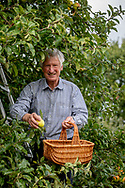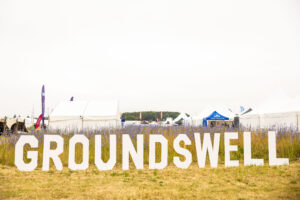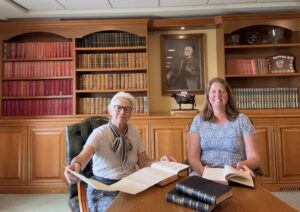
Côtard – or custard? – and the connection with ‘costermonger’?
We have received this comprehensive history of the Côtard apple variety, by Vincent Obbard of Samarès Manor

The Côtard is an apple listed in the excellent little book, Jersey Cider Apples, an Illustrated Collection, by Brian Phillipps and the late Rosemary Bett, published by the Société Jersiaise in 2008.
The fruit is described as: ‘large and cylindrical. Slightly rounded and angular.’ ‘Skin: dry and rather rough with many small russetted lenticels; ground colour a yellowish green.’
I have five Côtard trees which were actually grafted for me by Brian, so they are of good provenance. After a fine summer, the apples turn an attractive yellow custard colour. For reason of the yellow colour, I had imagined that the Côtard had obtained its name. Other Jersey apples have presumably obtained their names from how they look, like the one called ‘Museau d’Boeuf’ = ‘Cow’s muzzle’ and another called ‘Tétard’ = ‘Tadpole’ from the conical shape, blunt nose and projecting stem (tail). Also the ‘Pigeonnet’ = ‘little pigeon carcase’ (squab) from the plump conical shape and blue/green plumage colour.
This assumption of mine may not be right. The origin of the name, Côtard, at least, is probably Mediaeval, from the old French ‘Coste’ or side, hence ‘angular’. It may have nothing to do with ‘custard’, although, much later, it’s always possible that the idea of custard may have crept in.
The Mediaeval Costard was indeed a large ribbed greenish yellow cooking apple. It was by far the most popular apple in England, giving its name to the costermonger. According to Joan Morgan, author of ‘The New Apple Book’, records show that Costards were being imported from France in 1292, when an order for 300 lbs was sent to Edward 1 at Berwick Castle. They cost 12 pence a hundred, as opposed to just 3 pence for unnamed varieties. One reason for this interest in French apples was that Edward 1 was married to Eleanor of Aquitaine, so trade at this time with France was lively. Another apple which was imported from France was the ‘Blancdurel’, which survives in France to this day as ‘Calville Blanc’.
Shakespeare used the word Costard as a slang word for a head. In the play, Richard 111, the Duke of Clarence is prisoner in the Tower and is set upon by two murderers, one of whom suggests hitting him on the head with the sword handle (‘Take him on the Costard with the butt of thy sword’) and disposing of him in a barrel of malmsey (Madeira wine). Costard was also a leading character in Love’s Labour’s Lost. His plot to outwit his captors is the source of much amusement.
Although the Romans probably first brought the cultivation of apples with them to Britain, Norman rule in England brought with it the Norman enthusiasm for of growing fruit, sometimes together with herbs and vegetables, or sometimes in a separate orchard (‘hortus yard’). Orchards were often enclosed by a high wall.
Norman monasteries would usually have an orchard, so I can imagine the Priory at St Clement with a good walled orchard, tended by the Abbot. The fief of St Clément was owned by the Monastery at Mont St Michel.
My property, Samarès Manor, was owned by a Norman Seigneur, who would have maintained an orchard. I know from my own experience, how well apples still grow here in the fertile, moist, yet well drained, soil in the still subsisting walled garden.
So, is there a possibility that the Jersey Côtard is the same apple as the Mediaeval English Costard, which arrived in England from France with Edward 1, at which time it would have already been well established in the Channel Isles?
Sadly, the official view is that the English Costard has, despite its former popularity, probably died out. The nearest apple to it may be the ‘Catshead’, which is still listed as an available apple in The New Book of Apples. In profile, the outline is said to resemble a cat’s head. The Catshead differs, at least in the following respect, from the Jersey Côtard: the ‘eye’ (opposite the stalk) is ‘large and open’; whereas the eye of the Jersey Côtard is described by Phillipps and Bett as being in a ‘basin… small, narrow and shallow…. Sepals short and closed.’
Dr Robert Hogg in his fruit Manual published in 1884 thought that the Costard and the Catshead might have been one and the same apple. Quoting an earlier work by George Lindley, the entry for Costard in the Manual reads: ‘The large oblong five-ribbed and five-sided apple … is no doubt synonymous with the Catshead.’ (I can well imagine how the word ‘Costard’ can be confused with ‘Cat’s Head’ after a few glasses of cider!)
He goes on to say there are two other versions of the Costard, the Herefordshire Costard and the Gloucestershire Costard. The story is all very confusing.
One thing is for sure: The Jersey Côtard apple must be the same as the Côtard described by J. G. Speer in his article ‘Pommage’ published in the Société Jersiaise Bulletin 1970 volume 20, a most comprehensive study of Jersey apple names. It is part of a list of 65 apples provided to him by Frank Le Maistre, who described them in an Article for Le Bulletin d’Quart d’An de Assemblée Jèrriais No 9 Noué 1954. Mr Speer describes the Côtard as ‘Green and sour. December. It makes only a small tree but bears well.’
Incidentally, Mr. Speer does also mention an apple called ‘Tête dé Cat’ (‘Catshead’), described simply as ‘A keeping apple. Sour’. This apple is no longer recorded by Phillipps and Bett.
I have not been able to trace any earlier written references to the Côtard or Catshead before their mention in the Pommage article, although there are references to a number of Jersey apples in the cider making guide, ‘Apercu sur le Cidre’ by the Rev Francis Le Couteur 1801 and in the description of agriculture in the Island by Thomas Quayle in 1815. So it is possible the Jersey Costard or Côtard (or Catshead) was a relatively late introduction, not from Normandy, but from England. Quayle writes, in relation to apple varieties, ‘Many are imported from England, principally from the West…’
Indeed there does not appear to be any surviving apple in Normandy bearing the name of Côtard. In the text book ‘La Cidrerie Moderne, Ou l’Art de Faire le Bon Cidre’, by Jacquemin et Alliot published in 1902, there is a comprehensive list of recommended cider apples, which does not include the Côtard or Costard. Also, in the Normandy language journal Le Viquet No 77 of 1987 there is a detailed article by J Chaib, listing 187 different Normandy cider apples. The Côtard or Costard has no mention there either.
So, to summarise:-
There is no evidence to prove that our Côtard isthe original Costard which was introduced from France in the 13th Century or before;
There is no written record of the name Côtard in Jersey before the beginning of the 20th Century, and
There appears to be no surviving record of the name Côtard in Normandy.
So, maybe it was a relatively late import from England? With this in mind, I wonder if our Côtard bears any resemblance to Dr Hogg’s Herefordshire Costard or Gloucester Costard?
Unfortunately, in the race to identify and record all existing apples in the 1870’s, confusion reigned. In Hereford, Dr Hogg suggested that The Woolhope Naturalists’ Field Club should produce a Pomona of all known fruits in Hereford. The finest varieties were recorded by being carefully painted and made into lithograph pictures. At this stage, The Pomona appears to have made the elementary mistake of muddling up the Hereford Costard with the Gloucester Costard.
The 1870’s apple identification project expanded into a countrywide search for every known UK apple and from further afield, so that an Apple Congress was arranged to take place in Chiswick, West London in 1883. The hunt was on for the best apples, to record them scientifically, and to promote them. The Channel Isles and Sweden were invited to take part. Mr C B Saunders, nurseryman, of Jersey, did exhibit the Pigeonnet (but no Côtard).
Bernwode Fruit Trees Nursery, Buckinghamshire, have an excellent website and on it is published an interesting history of the Costard apple. I read that 2 Costards and 2 Catsheads were exhibited in Chiswick. The Costards were exhibited by nurseries in Hereford and Gloucester, but it appears that neither of these were true Costards.
Bernwode retain an interest in finding a true Costard. They write that they have 2 examples from Hereford. There is one at Wisley. Hatfield House has one, but it turned out to be an apple bred in the early 20th century! Keeper’s Nursery in Kent are said to have one, which is remarkably similar to an old tree known as the Wotton Costard. There is said to be a Crimson Costard known to the Marcher Apple Network in Hereford.
So where does the Jersey Côtard stand in all this? It would be fascinating to know. I mean to find out more, to start with, by sending a sample for identification to the National Fruit Collection at Brogdale this autumn.
I retain just a spark of hope that it may be possible to prove that the Jersey Côtard is indeed an ancient relic, dating back to the rule of the Channel Isles by the Dukes of Normandy. It’s an interesting thought. Nothing that I have read or been told categorically rules this out.
I have just learnt that in the London Horticultural Society (precursor to the RHS) catalogue of 1826, there were 2 entries for Catshead: ‘Catshead’ and ‘Catshead Round’. Another name for ‘Catshead Round’ is given as ‘Tête du Chat (of Jersey)’, described as ‘yellow and roundish, December to March’.
In the 1842 edition of the same catalogue, ‘Catshead’ has synonyms of ‘Costard’ and ‘Coustard’.
So what if the Jersey ‘Côtard’ = ‘Catshead Round’ = ‘Costard’?
Another ‘game changer’ may be this: I said above that there is no written record of the name Côtard before the beginning of the 20th Century. This is strictly true. However, there just may be a record in the form of a painting. Harriet Le Couteur was the wife of Sir John Le Couteur. He was well known as a soldier and local politician, but above all, a countryman and horticulturist, devoted to his agricultural heritage. He became a respected authority on Jersey cows and wheat varieties. Among all other achievements, he became Aide de Camp to Queen Victoria and was responsible for giving her a tour of the Island in 1846. He was an enthusiastic fruit grower. During the Island tour, they visited Saunders Nurseries, near Five Oaks, where at one time, it was said that there were thousands of fruit trees and exotic plants. Harriet painted exquisite water colours of Jersey apple and pear trees, said to represent a complete record of all Jersey apples growing in their garden from between 1831 and 1862.
Unfortunately it is not known where the paintings are to be found. I have personally heard it said that someone from Jersey went to see them and to take a photographic record, where the Le Couteur descendants kindly made them available. The paintings were situated ‘in a bank vault’ ‘somewhere in the West Country’ but no further details are remembered. Luckily, the photographic record of the paintings is still held by the Royal Jersey Agricultural Society in Trinity.
Is there a painting of the Côtard?
Can anyone lead me to the present whereabouts of the paintings? I would love to see them.
It’s certainly worth continuing the search for answers…
As time goes on, I continue to find out more of this fascinating history.




